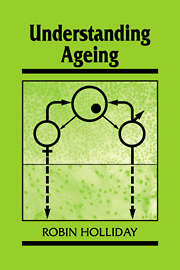Book contents
- Frontmatter
- Contents
- Preface
- Author's note
- Acknowledgements
- 1 Introduction
- 2 The evolved anatomical and physiological design of mammals
- 3 Maintenance of the adult organism
- 4 Theories of ageing
- 5 Cellular ageing
- 6 Genetic programmes for ageing
- 7 The evolution of longevity
- 8 Human disease and ageing
- 9 A better understanding of ageing
- Notes
- References
- Author index
- Subject index
2 - The evolved anatomical and physiological design of mammals
Published online by Cambridge University Press: 31 March 2010
- Frontmatter
- Contents
- Preface
- Author's note
- Acknowledgements
- 1 Introduction
- 2 The evolved anatomical and physiological design of mammals
- 3 Maintenance of the adult organism
- 4 Theories of ageing
- 5 Cellular ageing
- 6 Genetic programmes for ageing
- 7 The evolution of longevity
- 8 Human disease and ageing
- 9 A better understanding of ageing
- Notes
- References
- Author index
- Subject index
Summary
The recapitulation theory proposed that the development of an organism mimics the stages of evolution that lead to the adult species. In other words, ontogeny recapitulates phylogeny. The theory is no longer seriously considered, but it does illuminate a fundamental feature of complex organisms. Whereas machines are put together piece by piece, organisms start from a single cell, the fertilised egg, and through intrinsic processes produce a series of developmental stages of increasing complexity until the full-sized adult animal is formed. Nevertheless an animal has much in common with a machine; for example, the intake of energy and its conversion to output follow the same thermodynamic laws. The mechanistic aspects of movement and locomotion may be very similar. The articulation of joints and bearings have much in common, and the wings of bats and birds use the same aerodynamic principle of lift as do those of aeroplanes and gliders.
The comparison of animals and machines, like all analogies, can never be exact, but their similarities and differences are relevant to any discussion of ageing. Machines are designed and put together to produce the functional unit. The machine has no means of maintaining itself or repairing defects, except perhaps in special cases. The designer, of course, takes all steps to prevent parts wearing out, for example, by providing initial lubrication, frictionless joints, and so on, but any machine will eventually wear out unless it receives maintenance or repair from outside.
- Type
- Chapter
- Information
- Understanding Ageing , pp. 12 - 20Publisher: Cambridge University PressPrint publication year: 1995
- 1
- Cited by



